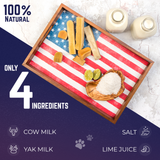Key Takeaways
- Elk stew is a hearty and protein-rich meal made from North America's prized wild game.
- The dish features lean elk meat combined with root vegetables and aromatic herbs.
- It is slow-cooked until the meat is fork-tender, enhancing its distinctive clean flavor.
- Elk stew offers a flavorful alternative that surpasses conventional beef stews.
Table of Contents
- What Is Elk Stew?
- Elk Meat, Nutritional Powerhouse and Sourcing
- Building the Flavor Base, Essential Ingredients
- Step-by-Step Cooking Methods
- Mastering Depth and Richness
- Regional and Modern Variations
- Serving Excellence and Storage Solutions
- Elk Stew vs. Other Wild Game Options
- Troubleshooting Elk Stew Challenges
- Mastering the Art of Elk Stew
Elk Stew: Wild Game Classic for Discerning Palates
Elk stew transforms North America's most prized wild game into a deeply satisfying, protein-rich meal that puts conventional beef stews to shame. This hearty dish combines lean elk meat with root vegetables and aromatic herbs, slow-cooked until fork-tender while preserving the meat's distinctive, clean flavor profile.
Unlike beef or venison alternatives, elk stew delivers superior nutrition, 25% more protein, 50% less fat, and triple the iron content per serving. The meat's natural leanness requires specific cooking techniques to achieve optimal tenderness, making this both a culinary challenge and reward for serious home cooks.
For those who appreciate the versatility of elk, consider rewarding your canine companion with a Large Whole Elk Antler Official Dog Chew or, for smaller breeds, an Extra Small Whole Elk Antlers Dog Chew as a healthy, natural treat.
What Is Elk Stew?
Elk stew is a slow-braised dish featuring cubed elk meat, vegetables, and savory broth cooked until the notoriously lean game meat becomes tender and flavorful. The cooking process breaks down tough connective tissues while preserving the meat's distinctive taste, cleaner and less gamey than venison, richer than beef.
This wild game classic originated in Rocky Mountain hunting camps where resourceful cooks transformed tough shoulder and neck cuts into satisfying meals. Modern elk stew maintains these rustic roots while incorporating refined techniques that maximize flavor extraction and ensure consistent tenderness.
Elk Stew vs. Other Game Stews
Elk stew distinguishes itself from beef and venison alternatives through its unique flavor profile and nutritional density. Where beef stew relies on marbling for richness, elk stew achieves depth through proper browning and extended braising of ultra-lean meat.
Key Differentiators: Elk contains zero antibiotics or hormones, provides 23g protein per 3oz serving (versus 19g in beef), and delivers a cleaner finish without heavy, gamey aftertastes common in venison stews.
Elk Meat, Nutritional Powerhouse and Sourcing

Elk meat delivers exceptional nutritional density that surpasses conventional proteins. A 100-gram serving provides 146 calories, 30 grams of protein, and only 1.9 grams of fat, making it ideal for athletes and health-conscious cooks seeking maximum nutrition without excess calories. For more details on elk as a food source, see this elk meat blog post.
| Meat Type | Protein (g) | Fat (g) | Iron (mg) | Calories |
|---|---|---|---|---|
| Elk | 30.2 | 1.9 | 4.4 | 146 |
| Beef (lean) | 26.1 | 8.7 | 2.9 | 183 |
| Venison | 26.5 | 3.2 | 3.8 | 149 |
Responsible Sourcing and Selection
Premium elk meat comes from two sources: wild-harvested through licensed hunting or farm-raised operations. Wild elk offers superior flavor complexity and guaranteed antibiotic-free meat, while farm-raised provides consistent availability and standardized cuts.
For stew preparation, shoulder, neck, and shank cuts deliver optimal results due to their connective tissue content, which breaks down during slow cooking to create natural thickening. These tougher cuts cost 30-40% less than premium steaks while producing superior stew texture. If you're interested in sustainable elk products for your pet, explore our elk antlers collection for a variety of natural chews.
Building the Flavor Base, Essential Ingredients
Successful elk stew begins with quality aromatics that complement rather than mask the meat's natural flavor. Yellow onions, carrots, and celery form the classic mirepoix foundation, while garlic, bay leaves, and fresh thyme enhance without overwhelming the elk's clean taste profile.
Rich beef or mushroom stock provides the liquid base, avoid game stock which can intensify gamey notes. Root vegetables like parsnips, turnips, and fingerling potatoes add substance while their natural sugars balance any residual wild flavors during the long cooking process.
Modern Flavor Enhancers
Strategic additions elevate basic elk stew into restaurant-quality dishes. Worcestershire sauce adds umami depth, while dried porcini mushrooms contribute earthy richness that pairs naturally with wild game. A splash of red wine or dark beer during deglazing captures fond flavors and adds complexity.
Pro Tip: Add tomato paste during the browning stage, its concentrated sugars caramelize with the fond, creating deeper flavor layers that complement elk's natural taste without competing.
Step-by-Step Cooking Methods
Proper elk stew preparation requires aggressive browning followed by gentle, extended braising. Cut elk into 2-inch cubes, season generously with salt and pepper, then brown in small batches over medium-high heat. This Maillard reaction creates the flavor foundation that distinguishes exceptional stews from mediocre ones.
Dutch Oven Traditional Method
Heat 2 tablespoons oil in a heavy Dutch oven until shimmering. Brown elk cubes in single layers, never crowd the pan or elk won't caramelize properly. Work in 2-3 batches, allowing each cube 3-4 minutes per side until deeply golden. Transfer browned elk to a plate and reduce heat to medium.
Add diced onions, carrots, and celery to the same pot, scraping up any browned bits. Cook 5-6 minutes until onions soften and develop light color. Stir in tomato paste and minced garlic, cooking another minute until fragrant. Deglaze with red wine or beef broth, scraping the bottom clean.
Return elk to the pot along with bay leaves, thyme, and remaining broth. Bring to a gentle simmer, cover, and transfer to a 325°F oven. Braise 1.5-2 hours until elk shreds easily with a fork. Add potatoes and root vegetables in the final 45 minutes to prevent overcooking.
Slow Cooker Method
Brown elk cubes in a skillet as described above, this step cannot be skipped even with slow cooking. Transfer browned meat to your slow cooker along with vegetables, herbs, and liquid. Cook on low 6-8 hours or high 3-4 hours.
Add quick-cooking vegetables like peas or green beans in the final 30 minutes. Thicken the finished stew by whisking 2 tablespoons cornstarch with cold water, then stirring the slurry into the hot stew during the last 15 minutes of cooking. For a premium chew for your dog that matches the wild spirit of elk stew, try the Jumbo Whole Elk Antler Dog Chew.
Mastering Depth and Richness

Layering Flavors for Maximum Impact
Professional-quality elk stew demands strategic flavor building at every stage. Start by seasoning elk cubes with salt 30 minutes before cooking, this draws out moisture for better browning and seasons the meat throughout. During browning, resist the urge to move pieces too quickly; proper caramelization takes patience and creates the foundation for rich, complex flavors.
Deglaze your pot with red wine, beer, or additional broth to capture every bit of caramelized goodness. This technique, called fond recovery, adds concentrated savory notes that separate restaurant-quality stews from home cooking attempts. Add aromatics in stages: hardy herbs like bay leaves and thyme go in early, while delicate herbs like parsley and fresh thyme get stirred in just before serving.
Taming Wild Game Character
Elk's distinctive flavor appeals to many, but some cooks prefer mellowing stronger game notes. Marinate cubed elk in buttermilk for 2-4 hours before cooking, the acidity breaks down proteins while neutralizing overly wild flavors. Alternatively, add a tablespoon of apple cider vinegar or a splash of balsamic vinegar during the final 30 minutes of cooking.
Strategic vegetable choices also balance game flavors naturally. Root vegetables like parsnips and turnips complement elk's earthiness, while mushrooms, especially dried porcini or shiitake, enhance umami depth without competing. A small amount of tomato paste (1-2 tablespoons) adds subtle acidity and richness without creating a tomato-forward stew. For a detailed look at the benefits and uses of elk antlers, check out this elk antlers blog article.
Pro Technique: If your finished elk stew tastes too gamey, stir in 2-3 tablespoons of heavy cream or sour cream just before serving. The dairy fat mellows strong flavors while adding luxurious richness.
Regional and Modern Variations
Rocky Mountain Hunter's Stew
This Western variation celebrates elk's natural habitat with indigenous ingredients. Add diced green chiles (Hatch or poblano), wild mushrooms, and a handful of cooked white beans during the final hour of cooking. Finish with fresh cilantro and a squeeze of lime for brightness that cuts through the rich, gamey flavors.
Many Rocky Mountain cooks incorporate local grains like wheat berries or barley, added with the initial liquid for hearty texture. The combination of altitude-grown vegetables and wild game creates an authentic taste of the American West that honors both tradition and terroir.
French-Style Elk Bourguignon
Transform traditional elk stew into elegant bourguignon by using a full bottle of red wine as your primary liquid, reducing the broth accordingly. Add pearl onions, thick-cut bacon, and button mushrooms for classic French presentation. The extended wine braising creates silky, sophisticated flavors perfect for dinner parties.
Thicken bourguignon-style elk stew with beurre manié (equal parts butter and flour kneaded together) whisked in during the final 10 minutes. This technique creates glossy, restaurant-quality sauce that coats each piece of tender elk beautifully. For another option, power chewers may enjoy the Jumbo - Split Elk Antler Dog Chew as a long-lasting treat.
Serving Excellence and Storage Solutions
Optimal Serving Suggestions
Serve elk stew in warmed bowls to maintain temperature and enhance the dining experience. Crusty sourdough bread, buttermilk biscuits, or cornbread provide ideal vehicles for soaking up the rich broth. For wine pairings, choose robust reds like Cabernet Sauvignon, Malbec, or Syrah that complement rather than compete with elk's bold flavors.
Garnish thoughtfully with fresh herbs, a drizzle of quality olive oil, or a dollop of sour cream. These finishing touches add visual appeal and bright flavor notes that balance the stew's hearty richness. Plan for 1-1.5 cups per serving as a main course, or smaller portions as a starter.
Proper Storage and Reheating
Cool elk stew completely before refrigerating to prevent bacterial growth and maintain optimal texture. Store in airtight containers for up to 4 days in the refrigerator or freeze for up to 3 months. Divide large batches into meal-sized portions for convenient reheating and faster cooling. For more on safe preparation and storage, see these game meat temperature and safety tips.
Reheat gently on the stovetop over medium-low heat, stirring occasionally to prevent sticking. Add a splash of broth if the stew has thickened too much during storage. Avoid microwave reheating when possible, it can create uneven heating and tough elk meat. Frozen elk stew thaws best overnight in the refrigerator before reheating.
Storage Tip: Elk stew actually improves after 24 hours as flavors meld and develop. Make it a day ahead for dinner parties or meal prep for even better results.
Elk Stew vs. Other Wild Game Options

Elk vs. Venison Stew Comparison
Elk delivers milder, more approachable flavors than venison while maintaining wild game character. Venison tends toward stronger, more metallic notes that require aggressive marinades or masking ingredients. Elk's larger muscle fibers and higher fat content create more tender, juicy results in slow-cooked applications. For a comprehensive look at the differences between antler types, read deer antler vs elk antler for dogs.
| Factor | Elk Stew | Venison Stew | Beef Stew |
|---|---|---|---|
| Flavor Profile | Mild game, slightly sweet | Strong, metallic notes | Familiar, rich beef |
| Protein Content | 26g per 100g | 24g per 100g | 20g per 100g |
| Fat Content | 2.4g per 100g | 1.8g per 100g | 15g per 100g |
| Cooking Time | 1.5-2 hours | 2-2.5 hours | 1.5-2 hours |
| Sourcing Difficulty | Specialty retailers | More widely available | Any grocery store |
Why Choose Elk Over Beef
Elk stew provides superior nutrition density compared to traditional beef stew. With 30% more protein and 85% less fat than beef chuck, elk creates lighter yet more satisfying meals. The lean profile means elk stew won't leave diners feeling heavy or sluggish, ideal for active lifestyles and health-conscious cooking.
Wild elk contains higher levels of omega-3 fatty acids and CLA (conjugated linoleic acid) than grain-fed beef, supporting heart health and inflammation reduction. These nutritional advantages, combined with elk's natural, hormone-free profile, make elk stew an excellent choice for clean eating without sacrificing flavor or satisfaction. For more on elk as a species, see the elk entry on Wikipedia.
Troubleshooting Elk Stew Challenges
Avoiding Tough, Chewy Results
Tough elk meat typically results from high-heat cooking or insufficient braising time. Elk's lean composition requires gentle, moist heat cooking methods, never boil elk stew vigorously. Maintain a bare simmer throughout cooking, with only occasional bubbles breaking the surface. If you want a smaller chew for your pet, try the Small - Split Elk Antler Dog Chew - 2 Pack for a satisfying treat.
If your elk stew turns out tough despite proper technique, the cut may be the culprit. Avoid lean cuts like backstrap or tenderloin for stewing, these premium cuts become dry and stringy with long cooking. Stick to shoulder, neck, or shank cuts that contain more connective tissue for natural tenderization.
Rescuing Watery or Bland Elk Stew
Thin, watery elk stew lacks the satisfying richness that defines great stew. Fix this by removing the lid during the final 30 minutes of cooking, allowing excess moisture to evaporate. Alternatively, create a cornstarch slurry (2 tablespoons cornstarch mixed with cold water) and stir into simmering stew until thickened.
Bland elk stew needs acid and umami enhancement. Add a tablespoon of tomato paste, a splash of Worcestershire sauce, or a handful of dried mushrooms during the final hour. Taste and adjust salt levels, elk's lean profile requires more seasoning than fatty beef to achieve proper flavor balance.
Mastering the Art of Elk Stew
Elk stew represents the pinnacle of wild game cooking, combining nutritional excellence with deeply satisfying flavors that connect us to America's hunting heritage. Success requires respecting elk's lean nature through gentle cooking methods, strategic seasoning, and patience for proper flavor development.
The investment in quality elk meat and proper technique pays dividends in both flavor and nutrition. Unlike processed alternatives, elk stew delivers clean protein, essential minerals, and authentic taste that reflects responsible wild game consumption. Whether you're feeding family or entertaining guests, mastering elk stew demonstrates culinary skill and appreciation for America.
Frequently Asked Questions
What are the best cuts of elk meat to use for making a tender and flavorful elk stew?
The ideal cuts for elk stew are shoulder, neck, and shank, these tougher muscles benefit from slow braising, which breaks down connective tissue and yields tender, flavorful meat. Using these cuts maximizes the stew’s rich texture and depth without sacrificing elk’s clean taste.
How does elk stew compare nutritionally and flavor-wise to traditional beef or venison stews?
Elk stew offers a leaner, higher-protein alternative with about 25% more protein and 50% less fat than beef stew, plus triple the iron content per serving. Flavor-wise, elk is cleaner and less gamey than venison, with a richer profile than beef, making it a standout choice for discerning palates.
What cooking techniques are essential to ensure elk meat becomes tender given its lean nature?
Slow, low-temperature braising is key, first brown the meat to develop flavor, then cook it gently with moisture over several hours to break down tough fibers without drying out the lean elk. Patience and proper seasoning ensure fork-tender results that highlight elk’s natural qualities.
Where can I source high-quality elk meat, and what are the differences between wild-harvested and farm-raised elk?
High-quality elk meat is available from specialty butchers, trusted game meat suppliers, and local hunters. Wild-harvested elk tend to have a leaner, more robust flavor due to natural diet and activity, while farm-raised elk offer consistent supply and milder taste but may have slightly higher fat content. Choose sources that prioritize ethical and transparent practices.






